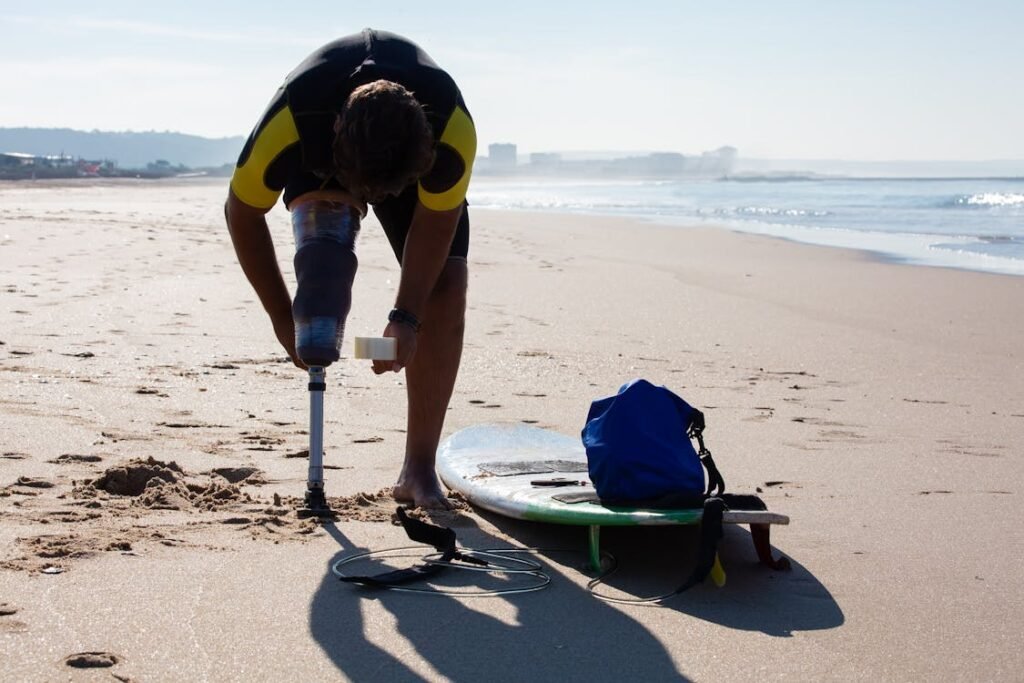Using a prosthetic limb is about more than just walking again. It’s about walking well—with comfort, balance, and confidence. But sometimes, even with a well-made prosthesis, things don’t feel quite right. You might notice soreness on one side of your body. Or maybe your steps feel uneven. You might be leaning more on your sound leg without realizing it. These are all signs of uneven weight-bearing—a problem that can slowly affect your comfort, your movement, and even your long-term health.
Uneven weight-bearing happens when your body doesn’t share weight evenly between both sides. For prosthetic users, this is a common issue, especially in the first few months of wearing the device. But it’s not just limited to new users. Even experienced wearers can develop habits or face changes in their limb or prosthesis that shift their balance over time.
If left unchecked, uneven weight-bearing can lead to pain in your residual limb, joint problems, backaches, and even socket fit issues. The good news? Once you learn to spot the signs early and understand what causes them, it becomes much easier to fix them.
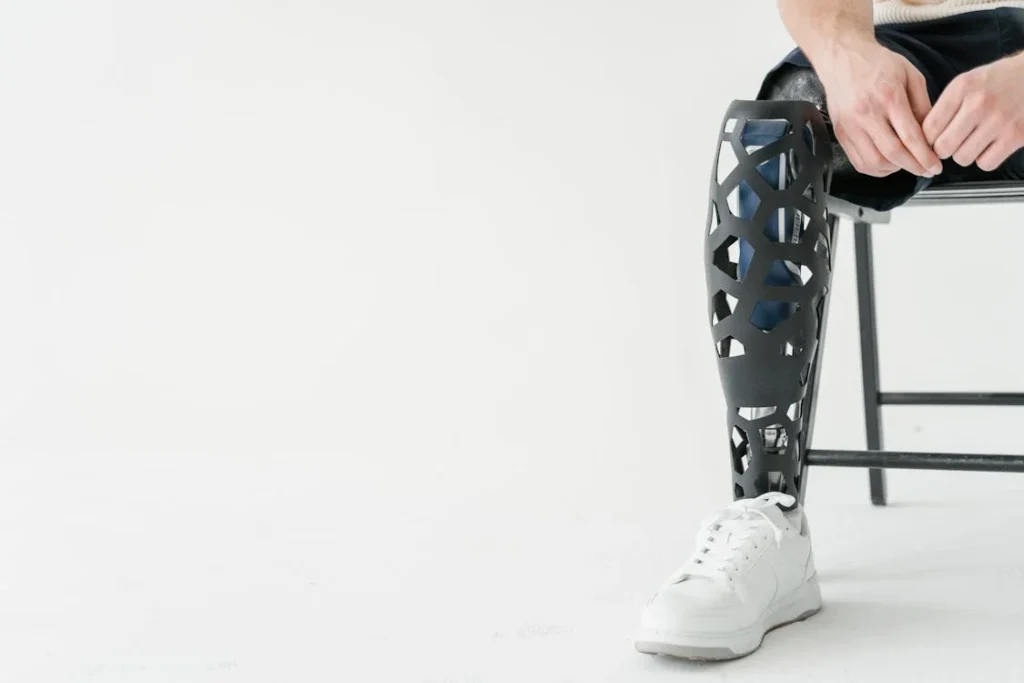
Understanding What Uneven Weight-Bearing Looks and Feels Like
Early Signs You Shouldn’t Ignore
Uneven weight-bearing often starts quietly. You may not feel pain right away. Instead, it might be something subtle—like a sense that one side of your body is working harder than the other.
You may notice that you’re leaning slightly when standing still, or that your prosthetic foot hits the ground differently than your sound limb.
These signs are small, but they’re important. They mean that your body is shifting its load unevenly, often to avoid discomfort or make up for poor alignment.
Sometimes, people unconsciously avoid putting pressure on their prosthetic side because they fear pain or don’t trust their balance. Over time, this creates a habit of favoring the sound limb.
That habit then leads to more problems, such as joint stiffness, muscle fatigue, and lower back pain. What starts as a slight imbalance can quickly affect how your whole body moves and feels.
If you find that your shoulders are not level when walking, or if your stride feels uneven, it could be a clue. Pain that builds up on one side after walking short distances is another common sign.
These imbalances are not just mechanical—they affect your posture, energy, and comfort in everyday life.
Why It Happens: Digging Into the Causes
There are many reasons why weight might not be shared evenly between your prosthetic and sound limb. One of the most common causes is a poor socket fit.
If your socket is too loose or too tight in certain areas, your residual limb won’t sit properly. This forces your body to adapt by leaning, shifting, or favoring the other leg, which throws off your natural balance.
Changes in the shape of your residual limb can also cause uneven weight-bearing. This can happen after weight gain, weight loss, muscle shrinkage, or even swelling after a long day.
When the shape of your limb changes but your socket doesn’t, pressure gets applied in all the wrong places.
Poor alignment is another major factor. If your prosthetic leg isn’t positioned correctly under your body, it changes how force travels from your body to the ground. Instead of moving in a straight, clean line, your weight shifts to one side, causing stress on your joints and tissues. Even a small misalignment in the angle or height of your prosthesis can create major imbalances over time.
Walking habits play a role too. If you’ve been limping or walking unevenly to avoid pain, that pattern becomes a habit. Over time, your muscles learn this new way of walking, even if it’s not ideal.
Correcting that takes awareness and sometimes the help of a physiotherapist or gait specialist who can observe and guide you.
Shoes can even be a problem. If your shoe soles wear out unevenly, or if you’re using a different height between shoes, it changes your alignment without you even noticing.
That small shift in height can lead to bigger shifts in how your body carries weight.
The Hidden Cost of Imbalance
When your weight isn’t shared evenly, your body starts to work harder than it should. The side carrying more weight—usually your sound limb—takes on extra pressure.
This can wear down your joints faster and lead to overuse injuries in your knees, hips, or lower back. Meanwhile, your prosthetic side gets weaker and may become less stable because it isn’t being used properly.
This imbalance can lead to fatigue even after short periods of walking or standing. Your body wastes energy trying to stay upright and keep your movements controlled.
You might notice that you feel tired sooner or need more breaks during the day. You may even find yourself avoiding certain tasks or limiting your mobility to avoid discomfort.
The emotional toll can also grow. Uneven weight-bearing can reduce your confidence.
If you don’t feel stable on your feet, you’re less likely to take steps outside, walk in crowded places, or engage in activities you once enjoyed. This can affect your social life, independence, and overall well-being.
Understanding these consequences is the first step to making meaningful change.
Once you recognize what uneven weight-bearing looks like—and how it affects your body—you can begin to fix it with small, practical adjustments that make a big difference over time.
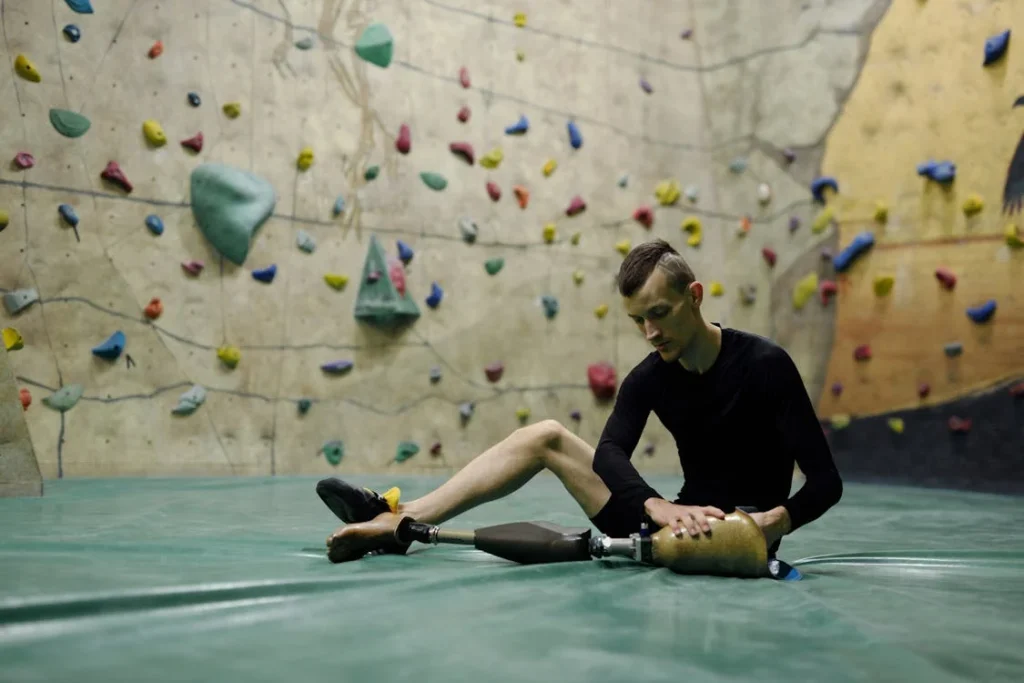
How to Identify Uneven Weight-Bearing at Home
Tuning Into Your Body’s Feedback
Your body speaks in quiet ways, and learning to listen is the first step in spotting uneven weight-bearing. You don’t need special tools or equipment to begin—just awareness.
Start by paying close attention to how you feel during and after simple activities. Standing in place, walking a few steps, or climbing a short flight of stairs can reveal a lot.
When standing still, check how your weight feels beneath each foot. Does one leg feel heavier or more grounded than the other? Do your shoulders feel even, or does one dip slightly?
Try closing your eyes and focusing on how your body sways. If your balance shifts to one side naturally, that’s a subtle sign of uneven load distribution.
During walking, listen to your steps. Are they quiet and smooth on both sides, or is there a louder impact or quicker pace on one leg?
Watch your reflection in a window or mirror. Does your body tilt, or do your hips move unevenly? If you record yourself walking, you may notice that one step looks shorter, or that your body rises and falls unevenly.
After walking or standing for a while, check in with your body. Does one knee, hip, or foot feel more tired than the other? If your residual limb feels sore while the sound leg feels fine, or vice versa, that’s your body showing where the load is being carried.
Redness, pressure marks, or swelling on your residual limb after removing the socket can also hint at imbalances.
Using Simple Tools for Observation
If you want more clarity, there are simple ways to test your balance at home. Try standing barefoot in front of a mirror with your arms relaxed by your side.
Check if your shoulders are level. Look at your hips—are they tilted? If you have a partner, ask them to place their hands gently on your shoulders and hips while you walk. They can often feel subtle shifts or dips you may not notice yourself.
You can also use a bathroom scale to check load distribution. Place one foot on each scale while standing evenly. Are the numbers close?
A big difference between the two tells you how much more load one leg is carrying. This isn’t a perfect test, but it can reveal trends—especially if repeated every week or two.
Another option is to wear a thin sock over your residual limb and then walk in your prosthesis for a short time. After removing it, examine the sock.
Are there wrinkles, tight spots, or stretched areas in specific places? These marks can show you where pressure is building unevenly inside the socket.
Even your shoes can help. Place them side by side on a flat surface and look at the wear on the soles. If one shoe is more worn down than the other, especially at the heel or toe, it’s a clear sign that weight is not being shared evenly.
This kind of wear pattern takes time to develop, but it tells the story of how your body moves over weeks or months.
What to Record and Share With Your Prosthetist
When you start to notice uneven weight-bearing, the next step is to track what you see and feel. Keep a small log of what you notice each day—how long you wore your prosthesis, how your limb felt afterward, what activities caused discomfort, and where you felt that discomfort.
These small notes add up over time and can help your prosthetist understand what’s really going on.
When you visit your clinic, bring this log with you. It gives your care team a clearer view of your daily life. Be honest about your habits, even if you feel they might be contributing to the problem.
The goal is not to be perfect—it’s to find patterns and correct them together.
Photos, videos, and even short recordings of your walking pattern can be incredibly helpful. They offer real insight that a single in-clinic visit might miss.
Sometimes, the issue only shows up after a long walk or during a specific movement. Capturing those moments makes it easier to create the right solution.
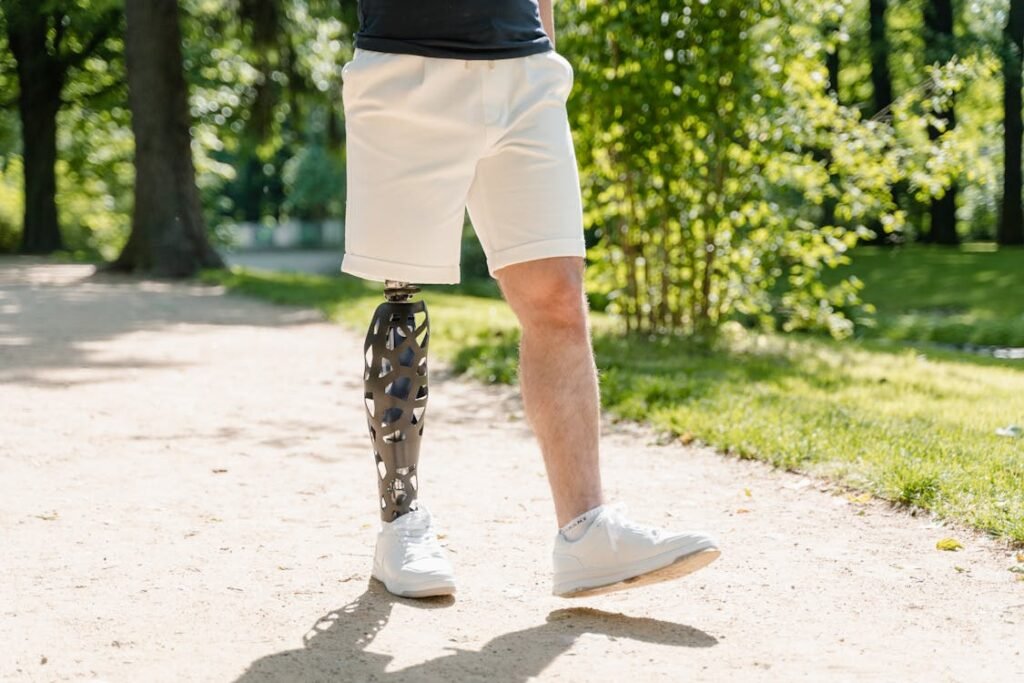
Fixing Uneven Weight-Bearing: What Really Works
Start With the Socket Fit
If your prosthesis doesn’t feel quite right, the socket is usually the first place to look. That’s the part that connects your residual limb to the rest of the device.
If it’s too loose in some areas or too tight in others, your weight won’t be carried evenly. This causes certain spots to carry more pressure, which leads to soreness, fatigue, or even skin problems.
A well-fitting socket should feel snug and even all around. You shouldn’t feel like one side is sinking deeper or sitting higher.
If you notice air pockets, pressure points, or frequent redness in specific areas, your socket likely needs an adjustment. This might involve reshaping the inner part, changing the liner thickness, or modifying how your limb sits inside it.
Working closely with your prosthetist is key. Don’t wait until the pain becomes sharp. Even mild discomfort is enough reason to ask for a review.
Remember, small tweaks can bring big improvements. A few millimeters of adjustment in one area might correct your posture and remove the strain on another.
Recheck Alignment and Height
Even if your socket fits perfectly, the rest of the prosthesis needs to be lined up with your natural posture. Alignment is how the prosthetic foot, knee (if applicable), and pylon connect and carry weight under your body.
If one part is angled incorrectly, it throws everything off. You might lean to one side, feel like you’re walking uphill, or find yourself favoring one leg without realizing it.
Height also matters. If the prosthetic leg is slightly shorter or taller than your sound limb, your hips will tilt as you walk.
That tilt causes weight to shift unevenly and can lead to long-term strain. You might feel it in your lower back or knees, or you might notice your gait becoming uneven without understanding why.
Your prosthetist can make adjustments to the alignment using tools and measurements that match your natural gait.
Sometimes this is done by eye during walking tests, and sometimes more detailed tools like pressure mapping systems or gait analysis are used. What matters most is how your body moves in the real world, not just how the device looks when you’re standing still.
Gait Training Can Change Everything
Once your prosthetic fit and alignment are adjusted, the next step is to retrain your body. You may have built habits that helped you move while the prosthesis wasn’t properly balanced.
Now, with everything aligned better, you need to re-learn how to walk with confidence and proper load-sharing.
This is where gait training with a physical therapist becomes incredibly helpful. A trained therapist can spot the small shifts in your hips, shoulders, or feet that you may not notice.
They’ll guide you through slow, controlled steps and help you focus on posture, weight transfer, and stride length. Over time, these new movement patterns become second nature.
Gait training also builds up strength where you need it most—especially in your hips and core. These muscle groups play a big role in keeping your upper body steady as you shift weight from side to side.
The more stable your core, the easier it is to walk evenly without compensating or leaning.
You don’t need fancy equipment to benefit. Even basic exercises done at home, such as standing on one leg, stepping in place, or walking in a straight line with guidance, can train your muscles and reset your walking pattern. The key is to be consistent and patient. Each small improvement adds up.
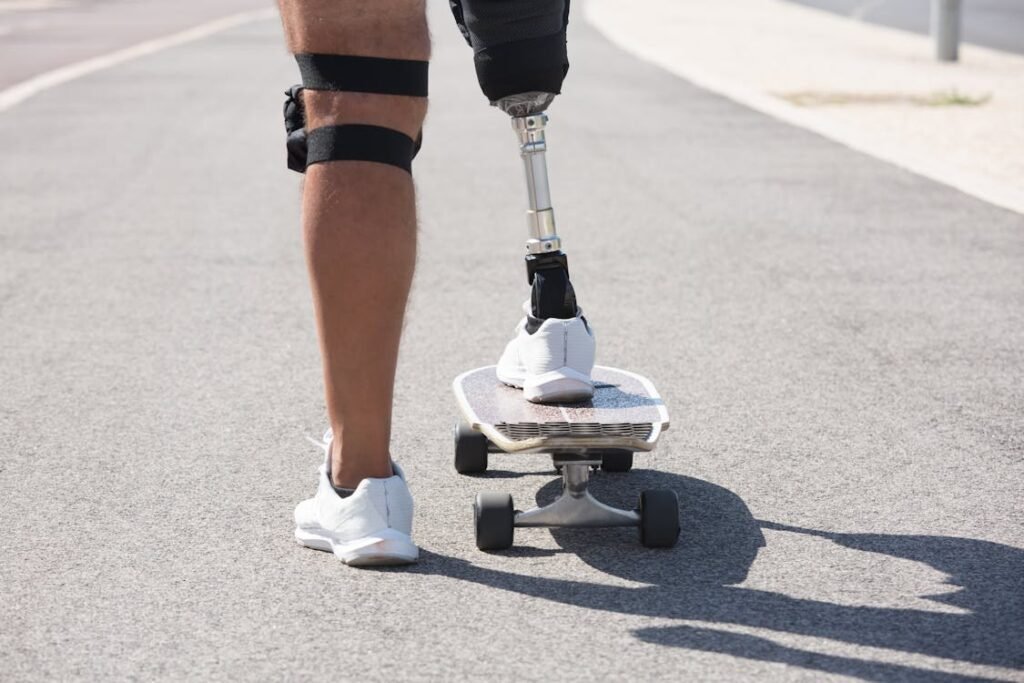
Daily Habits That Help Maintain Even Weight-Bearing
How You Stand Shapes How You Move
The way you stand when you’re not walking says a lot about your balance. Many prosthetic users tend to lean slightly toward their sound limb when they stop moving.
This happens without thinking—it’s a habit your body picks up to feel more secure. But over time, that small lean turns into a bigger problem. It teaches your muscles to work unevenly, it shifts your center of gravity, and it keeps you from distributing your weight equally.
A simple but powerful habit is to check your stance regularly. Whenever you’re standing still, pause and feel where your weight is going. Is it centered? Are you bearing down equally on both feet?
If not, shift gently until you are. This doesn’t need to be dramatic. It’s more about awareness than force. The more often you correct your posture, the more your body starts to remember that even balance is the default.
Mirrors can help. Stand in front of one and look at your shoulders, hips, and knees. Are they lined up? Are you favoring one side? Doing this once or twice a day builds awareness, and awareness leads to better control.
Rethinking How You Sit and Rise
How you move from sitting to standing affects how your weight is shared once you’re up. Many people instinctively push off using their sound limb or favor one side of the chair when standing.
This creates an uneven start to your step. If you rise from a tilted position, you begin your movement already off-balance—and your body carries that imbalance forward into your walk.
A better way is to plant both feet firmly before you stand. Focus on using your hips and not just your knees to push up. Try to rise smoothly, without leaning too far forward or backward.
If possible, keep your torso upright and steady. Practicing this helps your body remember how to lift itself using both sides more evenly.
This also applies when sitting down. Lower yourself slowly, using control from both legs rather than dropping quickly onto one side. The goal is to keep both limbs active—not just the sound one.
These daily movements, repeated again and again, either reinforce good habits or deepen poor ones. Being mindful during small actions builds a better foundation for bigger activities.
Managing Fatigue and Rest Periods
Even with good posture and perfect alignment, your body still needs rest. If your muscles tire, your form starts to fall apart.
That’s when you begin leaning, limping, or taking shortcuts that place more weight on one leg. To maintain even weight-bearing, it’s important to balance activity with recovery.
Pay attention to how your body feels throughout the day. If you start feeling soreness on one side, take a break before that discomfort turns into pain.
This doesn’t mean you have to stop everything—it might just mean sitting for a few minutes, stretching, or adjusting your socket. When you return to standing or walking, focus again on balance and posture.
Resting isn’t a setback. It’s part of the rhythm that allows your body to work better, longer. Over time, as your strength builds and your gait improves, you’ll be able to go further without strain.
But even then, taking small breaks ensures your weight-bearing stays smooth and even.
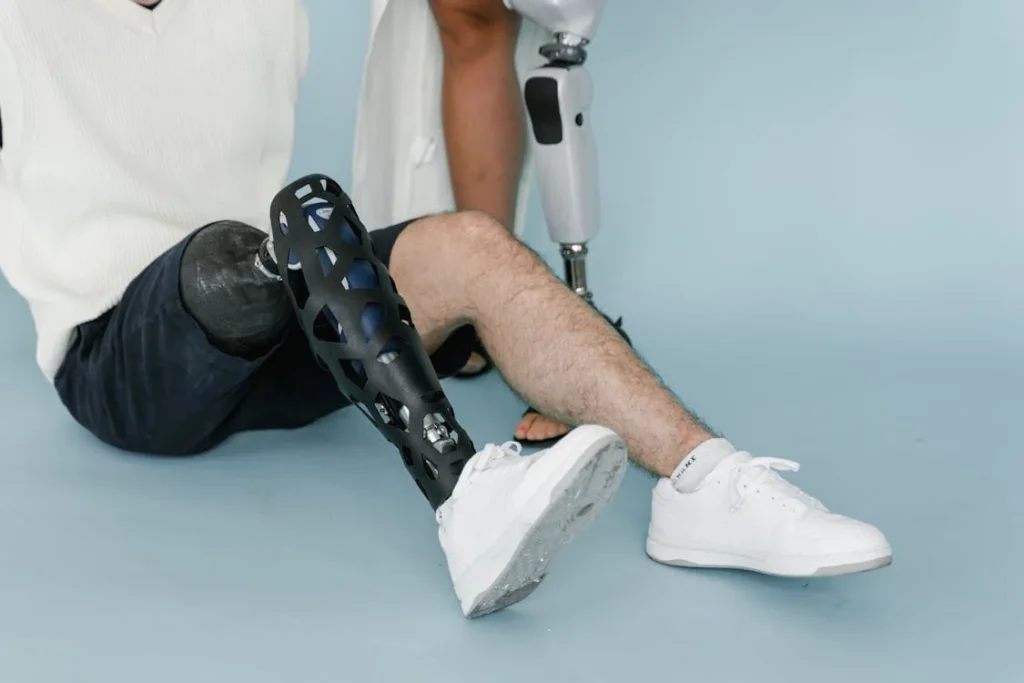
The Emotional Impact of Uneven Weight-Bearing — And How to Rebuild Confidence
When Every Step Feels Uncertain
Living with uneven weight-bearing doesn’t only affect the body. It also affects the mind. When your movements feel unstable or uncomfortable, your confidence naturally begins to slip.
You might second-guess every step, wondering whether your prosthesis will support you or whether pain will follow. This kind of uncertainty doesn’t just slow you down physically—it can stop you from doing the things you once enjoyed.
You may avoid longer walks, decline invitations, or choose to sit instead of stand—not because you can’t move, but because you no longer feel sure that movement will go smoothly.
That hesitation builds into anxiety. And soon, your world starts to shrink a little more each day.
This emotional strain often builds quietly. It might start as frustration—why does this still hurt? Why is my gait off again? Over time, that frustration can turn into fear.
Fear of falling. Fear of pain. Fear of being watched while walking differently. These feelings are completely natural, but they can hold you back from progress if left unaddressed.
Rebuilding Self-Trust Through Small Wins
The first step in regaining confidence is knowing that it’s okay to feel uncertain. No one expects perfection. Progress in prosthetic use is about patience, not pressure.
One of the best ways to rebuild emotional stability is through physical stability. When you take even one step that feels smooth and secure, it tells your brain: “I can do this.” And those small moments are powerful.
Practicing safe, supported movements at home can help. If standing evenly is hard, do it near a wall or countertop. If walking in public feels overwhelming, start with short walks in quiet areas.
Keep repeating these motions until they feel natural again. This builds muscle memory, but it also builds emotional strength. You learn to trust yourself—not just your prosthesis.
Celebrating these tiny wins matters more than you might think. Standing a little longer than yesterday, walking across the room without pain, or making it through the day without needing to adjust your socket—these moments are proof that you’re adapting. They might not seem like milestones, but emotionally, they are.
Finding Strength in Support
You don’t have to handle the emotional toll of imbalance alone. Talking to other prosthetic users who have faced similar issues can offer relief and perspective.
Hearing someone else say, “Yes, I went through that too,” can be incredibly validating. It reminds you that struggle is part of the journey—but so is growth.
Family and caregivers also play a role. Sometimes they want to help but don’t know how. Letting them in on what you’re feeling—physically and emotionally—helps them support you in ways that truly make a difference.
Maybe that means walking with you in the evenings, or simply listening when your socket doesn’t feel quite right. Emotional support often starts with honest conversations.
And don’t hesitate to speak with your prosthetist or therapist about mental strain. They understand that physical discomfort and emotional fatigue go hand in hand. The right adjustments to your fit or gait can ease not just pain, but worry too.
Confidence isn’t a switch—it’s something you rebuild, moment by moment. Uneven weight-bearing can take it away, but with time, awareness, and support, you can get it back—and walk with peace of mind again.
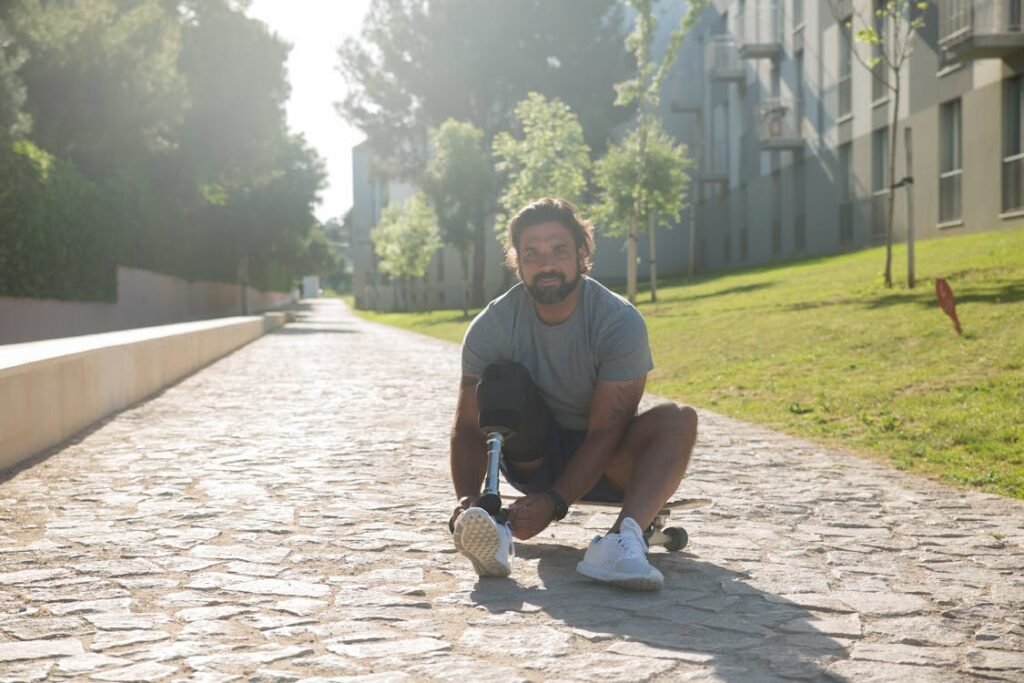
The Role of Technology in Detecting and Correcting Uneven Weight-Bearing
Beyond the Naked Eye: Why Technology Matters
While personal awareness and clinical observation are valuable, they don’t always catch the full picture of how your body moves.
Subtle shifts in balance, changes in gait, or uneven pressure points aren’t always visible to the eye—or even felt clearly until they’ve caused discomfort. That’s where technology steps in to provide deeper insight.
Modern tools can detect imbalances before they cause real problems. They offer precise data on how weight is being shared, how your joints are moving, and where pressure builds up during each step.
These tools don’t just confirm that something is off—they show exactly where and how it’s happening. This allows your care team to make more accurate adjustments and avoid guesswork.
It’s like getting a detailed map instead of just following your gut. That map can guide better alignment, socket adjustments, and even personalized rehab exercises—all of which help you walk better, longer, and with fewer setbacks.
How Pressure Mapping Can Help
Pressure mapping systems use smart sensors placed in your prosthetic socket or under your foot. These sensors record real-time pressure patterns as you stand, walk, or move through daily tasks.
The results show which areas carry too much load, which areas aren’t engaged enough, and how pressure shifts over time.
For prosthetic users, this is incredibly useful. You might think your socket fits well—until the pressure map shows one small area absorbing way too much force.
That single pressure point could be the reason you feel soreness by the end of the day. With this data, your prosthetist can add an insert, reshape part of the socket, or adjust your liner to fix the issue with precision.
These tools are especially helpful for people who can’t clearly describe their discomfort or whose pain shows up only after prolonged activity.
Pressure mapping makes the invisible visible—and that’s a game-changer for long-term comfort.
Gait Analysis for Fine-Tuned Adjustments
Gait analysis uses cameras, motion sensors, and even wearable trackers to study how your body moves when you walk. It measures things like stride length, joint angles, timing, and balance.
For a prosthetic user, this information is gold. It shows exactly how your prosthesis interacts with the rest of your body, including whether it’s helping or hindering your movement.
Let’s say your left step is shorter than your right, or your hip dips slightly with every stride. These small details may not cause immediate discomfort, but they create patterns of uneven weight-bearing that grow over time.
Gait analysis helps correct these early. The data lets your prosthetist tweak the height, tilt, or alignment of your prosthetic components to create smoother, more even movement.
This technology isn’t just for elite rehab centers anymore. More clinics, especially those partnered with modern prosthetics manufacturers, now use affordable gait tools to support their users better.
The goal isn’t to replace human care—it’s to enhance it with objective information that leads to smarter solutions.
Tech Tools That Support Daily Awareness
There are also tools you can use at home. Smart insoles and wearable fitness trackers can alert you when your balance shifts or when one side of your body is bearing more load.
Some mobile apps even track posture or analyze walking patterns over time. While these don’t replace clinical evaluations, they do offer helpful feedback in your everyday routine.
Imagine getting a gentle vibration from your insole when your weight drifts too far to one side. Or reviewing your walking data at the end of the day and spotting a change before it leads to soreness.
These small insights can help you make timely adjustments, avoid bad habits, and take control of your comfort.
Technology doesn’t need to be complex to be useful. Even simple digital tools can remind you to stand evenly, adjust your stride, or check in with your body.
Used regularly, these tools support a stronger connection between your mind, your movement, and your prosthesis.
Conclusion
Uneven weight-bearing isn’t always obvious, but its effects run deep. From the way you stand and walk to how your joints feel at the end of the day, imbalance can quietly shape your comfort, energy, and confidence. Left unchecked, it leads to pain, reduced mobility, and even emotional stress. But the good news is—once you know what to look for, you can take clear and simple steps to fix it.
Whether it’s adjusting your socket, retraining your gait, using smarter technology, or just becoming more aware of how your body feels, the path to better balance starts with paying attention. Every small change, when made with care, adds up to better comfort, smoother movement, and a greater sense of control.
At Robobionics, we believe that prosthetics should support not just your steps, but your life. And that starts with helping you move freely, evenly, and confidently—every single day. If you feel discomfort or instability in your walk, don’t ignore it. Reach out, get evaluated, and take action early. Because the more balanced your body feels, the more your life opens up.



